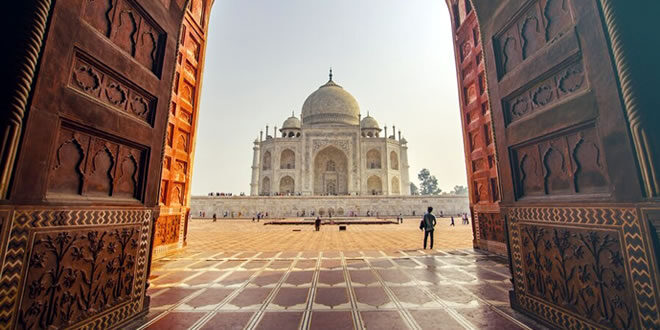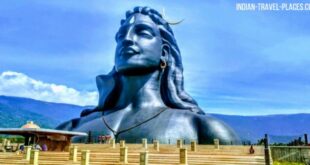| Name: | Agra (Known as the Dalit capital of UP) |
| Location: | 210 kilometres (130 mi) south of the national capital New Delhi; 335 km west of Lucknow |
| Climate: | Summers: 460 C (Max), 300 C (Min) | Winters: 280 C (Max), 060 C (Min) |
| Best Time to Visit: | August to April |
| Nearest Airport: | Agra Airport |
| Railway Station: | Agra Cantonment Railway Station – Other prime is ‘Agra Fort Railway Station’ |
| Must Visits: | Taj Mahal, Fatehpur Sikri, Red Fort (Agra Fort) and Akbar’s Tomb |
| Language Spoken: | Hindi, Urdu and Punjabi |
| STD Code: | 0562 |
Agra is a wonderful city in the north Indian state of Uttar Pradesh. It is situated on the banks of holy river Yamuna and just 200 kilometres away from the national capital, New Delhi. The city is spread over an area of about 189 square kilometres, at an altitude of 171m above the sea level. This is why; the climate of the city is classified as a semi-arid one, with hot and dry summers (460 C – 300 C), mild winters (280 C – 60 C) and a good monsoon season with an average rainfall of 660 mm annually. Thus, the best time to visit the city is from August to April due to its extreme climate situations. Agra city is home to three UNESCO World Heritage Sites – The Taj Mahal, Fatehpur Sikri & Red Fort, which makes it one of the most prominent tourist destinations in the world tourism map.
Agra is an integral destination in the famous golden triangle tour of India and is also on the main train line between Delhi-Mumbai and Delhi-Chennai. The city has its own airport which is just 12.5 km away from the city centre. It is well connected through other cities like Lucknow (363 km), Jaipur (255 km) and Gwalior (120 km) with regular bus services. Agra has a rich cultural and historical significance in India. Widely renowned as one of the major cities for having the seat for the Mughal kingdom, Agra however has a history that dates back to the period of the Mahabharata and Maharishi Angira in 1000 BC. During that era, it was named as Agrevana. According to the popular legends, the city is believed to be founded by Raja Badal Singh in around 1475. After succeeding many dynasties and empires, it was taken over by the legendary empire of Mughals (1526-1658), who revolutionized its historical, architectural and cultural heritage.
Agra shines like a gem in the tourism industry of India as well as that of the world. Thus, tourism is one of the most prominent factors that largely influence its economy. In fact, Agra houses Asia’s largest spa named Kaya Kalp – the Royal Spa in Hotel Mughal. Apart from that, it is also home to some of the finest world-class hotels of India. Other than tourism, leather industry is the most traditional and conventional industry of Agra. Kinari Bazar and Choube Ji ka Fatak are some destinations that are shopper delights. You can shop authentic silver, gold and artificial jewelry from here. Apart from the world heritage sites, one can explore other historical attractions like Tomb of Itmad-ul-Daulah, Jahangir Palace, Diwan-I-Aam, Diwan-I-Khas, Moti Masjid, Jama Masjid, Dayalbagh Temple, Khas Mahal, Nagina Masjid, Sheesh Mahal, and Sikandra (Akbar’ Tomb) etc. Once felt the vibrancy of this historical city, it would be a lifetime experience for you!
Best Time To Visit Agra
If you are looking to travel a beaten path and while away your vacation in a place that exudes grandeur and stateliness, then the historical city of Agra might be your ultimate destination. Situated 200 km away from the capital city of New Delhi, this sprawling city, which melds history with heritage, sashays the splendor of its royal past with perfect panache. With its slew of historical memorials, a jaunt down the lanes of Agra is like history revisited. This hugely crowded city is always mobbed by curious wanderers who flock in large numbers to capture the essence of the Taj Mahal and explore its architectural delights. If you are truly intrigued by India’s history and wish to get a slice of its past splendor, then making a quick trip to Agra would be a great idea. However, before you schedule your trip, do check out for the weather as Agra is endowed with extreme climatic conditions. Trail this write-up to get a perfect know-how on when to go to Agra and enjoy your stay there.
When To Go To Agra
Weather
Like most other cities in northern India, Agra too experiences extreme weather conditions, with sizzling hot summers and foggy, cold winters. During the summer months of April, May and June, Agra blazes with extreme heat with the average temperature scuttling somewhere between 370C to 440C. The city receives heavy rainfall during July that lasts until the initial weeks of September. During the end of September, the winter chill sets in with occasional post-monsoon showers further adding to the chill. Winter begins in October and continues until January with temperatures dropping down to 70C on extreme cold days. During the months of January, the city sometimes experience ‘Western Disturbances’ that is caused by the storms occurring in the Mediterranean Sea and Atlantic Ocean that give rise to rainfall in the northern part of the sub-continent.
Opting For Your Favorite Season
If you enjoy a hot summer day and prefer humidity to chilly winter days, then you should visit the city anytime between March to June. Summers in Agra can be very intense and can leave you feeling exhausted at the end of the day. So ensure to carry a lot of cold beverages, hats and sun creams for maximum protection while touring the place. Even if you prefer the monsoons, its best advised to stay away from the city during the rainy season as the city receives rampant showers during this time of the year that might mar your travel plans. Nevertheless, you could visit Agra during the months of September and October when the city receives post-monsoon showers. Winters in the city is very cold. Agra experiences extreme winters. So, make sure to carry few warm clothing to keep the chills away.
Best Time To Visit
The best time to visit Agra is anytime between November to March when the weather is most pleasant here. Like Delhi, Agra also experiences sweltering heat. Hence, it is best to stall your travel plans until later months of the year. Since the city experiences severe weather changes, visiting it during the months of September to November and March to May would best suit your travel plans.
History Of Agra
Overwhelming splendor, attractive monuments and exquisite traditions makes Agra cynosure India. Being the ultimate stopover for travelers from around the world, Agra stands as a true masterpiece of Mughal architecture that truly captivates your attentions with its buzzing lifestyle and spellbinding history. The city of Agra, which once served as the majestic dais for Indian rulers, has its mention even in the greatest Hindu epic of Mahabharata. Much of the city’s inspiring past breathes even in this contemporary world through its alluring structural gifts. With the vibrant cultural and religious history of nearly 3000 years, Agra boasts of power, compassion, love, refinement and above all the affection towards art and artifacts. The land, which testifies to the magnificent Mughal rule, is popular in the entire world for its stunning white marble beauty, the Taj Mahal, built by Emperor Shah Jahan in memory of his beloved wife Mumtaz. With fond reminiscences, royal heritage, rich culture and cherished legacies of nostalgic past, Agra holds on to its historical heritage with great pride. Go ahead and explore the history of Agra and explore the majesty of the land.
Agra History
Agra, The Land of Glorious Past
Agra, perched on the banks of the River Yamuna, is one of the oldest cities in India. In fact, one can find the mention of this city in the great epic of Mahabharata, in which the region of Agra is described as ‘Agraban’, which served as an integral part of Brij Bhumi, the land of Lord Krishna. In the pre-historic period, Agra was believed to be inhabited by the Aryans who named the land as ‘Arya Griha’. However, according to the records, the earliest mention of Agra was made in 1475 A.D, during the reign of Raja Badal Singh, who is believed to be the actual founder of the city. The glorious history of Agra starts during the Afghan ruler Sikandar Lodhi era, who made Agra his capital. After the death of Sikandar Lodhi, his son Ibrahim Lodhi administered the entire Delhi Sultanate from Agra.
Golden Age Of Mughal Rule
Agra, the land of finest culture and unique character flourished under the hands of the spectacular Mughal rule. In the year 1526 A.D, Babar defeated Lodi’s in the First Battle of Panipat and conquered Agra. After Babar, his grandson Akbar became the most noted ruler under whom the city transformed into a hub of art, culture, commerce and learning centre. The city flourished into a land of astonishing architectures. His son Jehangir also built a number of monuments in Agra such as palaces, courts and gardens. After the death of Jehangir, his son Shah Jahan shifted his empire to Delhi and left the impact of his rule by building the world famous Taj Mahal in the memory of his beloved wife Mumtaz. The ravishing Taj Mahal, which took nearly 20 years to complete, stands as a brilliant venture of Shah Jahan. Later, during the rule of Aurangzeb, Agra regained its captaincy. Thus, with nearly a century of Mughal rule, Agra became the pride of the country by its skilled craftsmanship, contemporary Mughal style architecture and most importantly, the luscious Mughlai cuisine. However, with the end of Mughal rule, Agra came under the Marathas, Jats and then British until the country’s Independence in 1947.
How To Reach Agra
Chockablock with a plethora of breathtaking tourist hotspots, a slew of archaic bazaars, and a spate of local eateries offering lip-smacking Mughlai fare, Agra truly inspires awe among its visitors. Tucked away in the northern part of Uttar Pradesh, close to the banks of River Yamuna, Agra apparently ranks high among the top most populated cities in India. Despite of its frippery and commercialism, Agra has managed to capture the imagination of many with its impressive array of architectural wonders like Taj Mahal, Agra Fort, Fathepur Sikri and Jama Masjid that offers a dynamic view of the city’s past splendor. What’s more, from Agra you can plan a quick daytrip to the nearby cities of Delhi, Jaipur and Gwalior that hosts a hatful of attractions for the tourists. Tourism being one of Agra’s prime sources of revenue generation, the city is well-linked to most of the Indian cities by excellent transport facilities. Be it road, rail or air, Agra is connected to the rest of the country by an impressive network of transport. To know how to reach Agra comfortably and conveniently, trail the article below and have a safe trip to the city.
Traveling To Agra
By Air
The Agra Airport is a military airbase that is maintained by the Indian Air force and is open to commercial airline carriers too. The Agra airfield is said to one of the largest military air strips in the country. The airport is located 12.5 km away from the city. Although, the airport does not link to any international destinations, the city is connected to all the major cities of India by domestic air carriers. However, if are looking for the closest international airport, then Indira Gandhi International Airport in New Delhi, which is located 200 km away from the city, is your best option.
By Rail
If you plan to travel to Agra by railways, then Agra has a plethora of trains to take you to the city comfortably. Agra has three important railway stations where several trains make a scheduled stop. Agra Fort Railway Station, Agra Cantt and Raja ki Mandi are the three main railway stations that connect the city to the popular cities of Delhi, Mumbai, Kolkata, Chennai, Hyderabad, Bangalore, Pune, Indore, Jaipur, Lucknow and many other cities in India.
By Road
The national highways connecting Agra and other nearby cities are well maintained and in good condition. So you can be assured of a smooth comfortable journey as you head to city. If you are traveling from Delhi, then the fastest route would be the NH 2. The distance between Agra and Delhi is just 200 km and can be covered within a span of 4 hours. For those who are commuting from Jaipur, it is usually suggested that you take the NH 11 as it is the best four-lane freeway that connects Agra via Bharatpur. As for people travelling from Mumbai and Gwalior, NH 3 is a good option. The NH 2 and NH 25 are used by passengers journeying from Lucknow and Kanpur.
Places To Visit In Agra
Located in Uttar Pradesh, close to the capital city of Delhi, Agra always draws tourists in large numbers. According to the city’s early history, Agra was founded by Muslim ruler Sultan Sikandar Lodi in 1504. Later, in 1556, a general named Samrat Hem Chander Vikramaditya captured the place and restored Hindu rule in the region. Agra became the strongest citadel of power in Northern India for the Mughal Empire during the 5th century before the place was seized by the Marathas and the Jats. The royal supremacy over the land came to an end after the East Indian Company took over it. Once home to diverse leaders, Agra is wadded with many spectacular monuments that are worth visiting. Apart from the world famous Taj Mahal, the city has tons of other popular sightseeing places like Agra Fort, Fatehpur Sikri, Itimad-Ud-Daulah, Sikandara, Jama Masjid and the list is almost endless. Scroll down this write-up to known all about places to visit in Agra and plan your itinerary accordingly.
Tourist Attractions In Agra
Taj Mahal
Built by Shah Jahan as a souvenir for his much loved wife Mumtaz, the Taj Mahal is one of the Seven Wonders of the World and a World Heritage site. The structure is raised completely in white marble and is a breath taking sight to behold. This dome shaped structure comprises of four columns with domes on top of each pillar. This symmetrical monument is located close to the River Yamuna took 22 years of hard labor to finish the structure. The interiors of the structure are decorated with intricate ornate patterns and semi-precious stones. The best time to catch a glimpse of the Taj Mahal is during first light of the day or on a full moon night when the view is magnificent and cannot be adequately described in words.
Agra Fort
Also known as the Red Fort is more than 1000 years old and was restored by Akbar the Mughal Emperor in 1565. Built out of red sandstone is another World Heritage site the fort was converted into a palace that flaunts the skilled marble and ‘pietra dura’ craftsmanship. The focal points inside the fortress are Pearl Mosque, Public and Private Audience halls, Shish Mahal, Jahangir Mahal, Khas Mahal and the Musamman Burj. The fort holds great importance to the Indian history and is worth visiting.
Fatehpur Sikri
Located 35 km away from the city, the fort was built by the Mughal monarch Akbar in 1601 CE. The stronghold was erected by Akbar with the intention to make Fatehpur Sikri as his military center of operations. Made of red sandstone with beautiful carvings in black and white marble, the structure is an overwhelming sight and is another World Heritage Site.
Itimad-Ud-Daulah
Often referred to as a jewel box or Baby Taj, the Itimad-Ud-Daulah was built by Empress Nur Jahan for her beloved father. Located on the banks of the River Yamuna, the tomb is considered to be a smaller version of the Taj Mahal. This mausoleum is built in white marble that consist of delicate carvings, pietra dura, lattice work that where famous during the Mughal period. The monument is also crusted with semi precious stones such as jaspers, onyx, topaz, cornelian, lapis etc. The tomb has both the parents of the Empress laid alongside just like the tombs of Shah Jahan and Mumtaz in the Taj Mahal. Itimad-Ud-Daulah is a beautiful sight and a main architectural monument of Agra.
Sikandar
In the major suburbs of Agra lies the tomb of Akbar, an iconic figure in the history of India. Spread across 119 acres of land, it is believed that the Emperor himself commissioned the construction of his tomb in 1545 that was later finished by his son Jahangir in the year 1613. As for the structural design, the vault was constructed in red sand stone and marble and the ornamentation on the walls comprises of geometric patterns and calligraphy outlines and elaborate floral sketch. The entrance way has wide arches accompanied with several minarets on top of the building that are common feature found in Mughal structures.
Jama Masjid
Located right across the Agra Fort is one of India’s largest mosques. Built by Shah Jahan for his most much-loved daughter Jahanara Begum in the year 1648, the Jama Masjid is a hallmark structure in Agra. The mosque is built on a platform with entrance arch ways leading to the courtyard. The structure also has three large domes at the top and is made of sandstone. Each of these tombs is notable with its criss-crossed marble lines. Located in the heart of the city and close to the marketplace, the mosque is a familiar landmark in Agra.
Shopping In Agra
No vacation is complete without a little bit of retail therapy. No matter which place you happen to go, bingeing on the local souvenirs is one fun experience that cannot be paralleled. Sure, gaping at the iconic Mughal architecture, Taj Mahal and experiencing the other architectural delights in Agra is an overwhelming experience. Nevertheless, there is more to Agra than just its iconic monument of love and its spate of heritage sites. Apart from the historians and the epicureans, Agra has loads to offer to its discerning shoppers as well. Right from stone studded jewellery to beautiful carpets to metal figurines, you can shop for indigenous arts and crafts here. As you stroll along the bazaar lanes, you will realize that Agra is every shopper’s haven. The best part of shopping in Agra is that you can always haggle your way through the best deals. Some of the well-known shopping areas in the city are Sadar Bazaar, Munro Road, Taj Ganj, Gawalior Road, Kinari Bazaar and Pratap Pura. To get to know more about the shopping places in Agra, read through the following write-up.
Things To Buy In Agra
Marble
When shopping in Agra, you just can’t get away without splurging on the marble crafts that are the highest selling art pieces here. Whether you wish to take back home a miniature marble replica of Taj Mahal or splurge on meticulously designed exquisite marble crafts like vases, tabletops, ashtrays and ornamental boxes, the state emporiums here have loads to offer to the shoppers. However, make sure you don’t get duped by fake soapstone artifacts that are crystalline in nature. Make sure you buy your marble artifacts from authorized stores only.
Leather Goods
Whether you wish to indulge in leather boots, belts, bags, gloves, shoes, slippers or jackets, Agra is the place to go. Agra has a booming leather market from where you can get the best deals on leather goods and accessories at affordable prices. The best place to buy leather products is at Sadar Bazaar, Munro Road and Kinari Bazaar from where you can pick amazing leather stuff at amazing deals. Other good places to splurge in leather products are Shilpagram Crafts Village and Gangotri Emporium.
Carpets
Another must-buy item in Agra is its exquisite, eye-catching rugs and carpets. Carpet weaving that has been in vogue since the Mughal era that continues to draw potential buyers even today from different parts of the world. You can choose from a plethora of hand woven rugs, mats, wall hangings and carpets or opt for the industry manufactured ones. The carpet shops are concentrated close to Taj Mahal complex. You can pick carpets of every possible design, finish and rates from the shops lined up in Sadar Bazaar, Munro Road and Kinari Bazaar. However, the best place to pick up these carpets at a cheap price is from the Shilpagram Crafts Village.
Metal Wares
Besides the above mentioned artifacts and goods, the city is also well known for its brass work. There are several government managed emporiums that sell brassware at very nominal prices. Some of the brass items available here are metal sculptures, ornamental boxes, traditional water pipes, plates, jars, vases, safe boxes etc. The best places to buy these metal wares are Gangotri Emporium, Shilpagram Crafts Village and the shops in Munro Road and Sadar Bazaar.
 ITP Indian Travel Places: Food, Travel, Tourism Business Events and Trade Shows
ITP Indian Travel Places: Food, Travel, Tourism Business Events and Trade Shows







